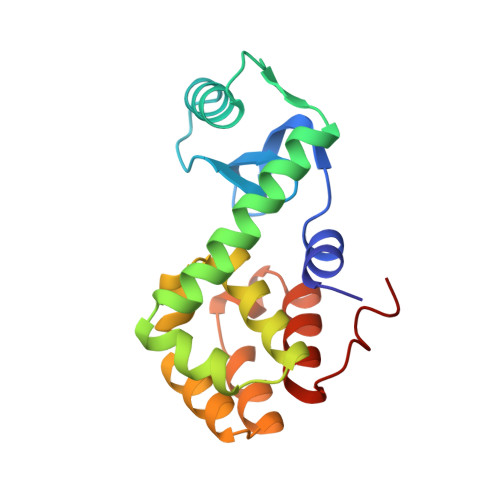Analysis of the effectiveness of proline substitutions and glycine replacements in increasing the stability of phage T4 lysozyme.
Nicholson, H., Tronrud, D.E., Becktel, W.J., Matthews, B.W.(1992) Biopolymers 32: 1431-1441
- PubMed: 1457724
- DOI: https://doi.org/10.1002/bip.360321103
- Primary Citation of Related Structures:
1L56, 1L60 - PubMed Abstract:
It was previously shown that the two replacements Gly 77-->Ala (G77A) and Ala 82-->Pro (A82P) increase the thermostability of phage T4 lysozyme at pH 6.5. Such replacements are presumed to restrict the degrees of freedom of the unfolded protein and so decrease the entropy of unfolding [B. W. Matthews, H. Nicholson, and W. J. Becktel (1987) Proceedings of the National Academy of Science USA Vol. 84, pp. 6663-6667]. To further test this approach, three additional replacements--G113A, K60P and A93P--have been constructed. On the basis of model building, each of these three replacements was judged to be less than optimal because it would tend to introduce unfavorable van der Waals contacts with neighboring parts of the protein. The presence of such contacts was verified for G113A and K60P by conformational adjustments seen in the crystal structures of these mutant proteins. In the case of G113A there are backbone conformational changes of 0.5-1.0 A in the short alpha-helix, 108-113, that includes the site of substitution. In the case of K60P the pyrrolidine ring shows evidence of strain. The thermal stability of each of the three variants at both pH 2.0 and pH 6.5 was found to be very close to that of wild-type lysozyme. The results suggest that the procedure used to predict sites for both Xaa-->Pro and Gly-->Ala is, in principle, correct. At the same time, the increase in stability expected from substitutions of this type is modest, and can easily be offset by strain associated with introduction of the alanine or proline. This means that the criteria used to select substitutions that will increase thermostability have to be stringent at least. In the case of T4 lysozyme this severely limits the number of sites. The analysis reveals a significant discrepancy between the conformational energy surface predicted for the residue preceding a proline and the conformations observed in crystal structures.
Organizational Affiliation:
Institute of Molecular Biology, Howard Hughes Medical Institute, Eugene, Oregon.















